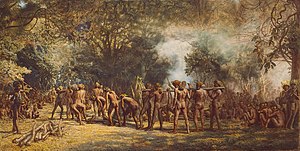
Cannibalism in Oceania is well documented for many parts of this region, with reports ranging from the early modern period to, in a few cases, the 21st century. Some archaeological evidence has also been found. Human cannibalism in Melanesia and Polynesia was primarily associated with war, with victors eating the vanquished, while in Australia it was often a contingency for hardship to avoid starvation.
Cannibalism used to be widespread in parts of Fiji (once nicknamed the "Cannibal Isles"),[1] among the Māori people of New Zealand, and in the Marquesas Islands.[2] It was also practised in New Guinea and in parts of the Solomon Islands, and human flesh was sold at markets in some Melanesian islands.[3] Cannibalism was still practised in Papua New Guinea as of 2012, for cultural reasons.[4][5]
- ^ Sanday, Peggy Reeves (1986). Divine Hunger: Cannibalism as a Cultural System. Cambridge, UK: Cambridge University Press. p. 151. ISBN 978-0-521-31114-4.
- ^ Rubinstein, William D. (2014). Genocide: A History. New York: Routledge. pp. 17–18. ISBN 978-0-582-50601-5.
- ^ Knauft, Bruce M. (1999). From Primitive to Postcolonial in Melanesia and Anthropology. University of Michigan Press. p. 104. ISBN 978-0-472-06687-2.
- ^ "Cannibal Cult Members Arrested in PNG". The New Zealand Herald. 5 July 2012. ISSN 1170-0777. Retrieved 28 November 2015.
- ^ Raffaele, Paul (September 2006). "Sleeping with Cannibals". Smithsonian Magazine.